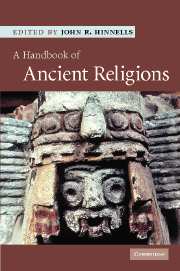Book contents
- Frontmatter
- Contents
- List of illustrations
- List of maps
- List of tables
- List of contributors
- Introduction
- 1 Palaeolithic art and religion
- 2 Ancient Egypt
- 3 Religion in ancient Ugarit
- 4 Mesopotamia
- 5 Ancient Israel to the fall of the Second Temple
- 6 Greek religion
- 7 Religions in the Roman Empire
- 8 Ancient Europe
- 9 The Indus Civilization
- 10 The religion of ancient China
- 11 Aztec and Inca civilizations
- Index
- References
7 - Religions in the Roman Empire
- Frontmatter
- Contents
- List of illustrations
- List of maps
- List of tables
- List of contributors
- Introduction
- 1 Palaeolithic art and religion
- 2 Ancient Egypt
- 3 Religion in ancient Ugarit
- 4 Mesopotamia
- 5 Ancient Israel to the fall of the Second Temple
- 6 Greek religion
- 7 Religions in the Roman Empire
- 8 Ancient Europe
- 9 The Indus Civilization
- 10 The religion of ancient China
- 11 Aztec and Inca civilizations
- Index
- References
Summary
The study of Roman ‘paganism’
The study of Roman pagan religion as a separate subject does not go back before the early nineteenth century. In its relatively short history it has been dominated by a small number of ideas that have sometimes been seen as almost beyond challenge. The keynote was set from the very beginning as a story of ‘decline’. The idea was that the religion of the very earliest Romans was closely adapted to their needs but that for one reason or another its development was stunted, so that it became progressively more and more stultified and ritualized and remote from the needs of the worshippers. Proof of all this was thought to come from the last generation of the Republic for whom religion had become nothing more or less than a meaningless set of rules. These could be freely exploited by anybody who wished to, as the source of useful political manoeuvres or for any other advantages, without thought about the gods and goddesses who were supposedly the objects of the worship.
By the end of the nineteenth century this view had become well established as an orthodoxy. At that date the great handbook of Georg Wissowa enshrined a certain approach to the subject. The book is a mine of information about the religious institutions of Rome and still provides the fullest and safest source for such information; but it is organized in a legalistic framework that implies a vision of the system in which it parallels the constitutional law so much admired at the time.
- Type
- Chapter
- Information
- A Handbook of Ancient Religions , pp. 318 - 363Publisher: Cambridge University PressPrint publication year: 2007
References
- 1
- Cited by



